Diagnostic Scoping Paper: MH HDU Preadmission Education Program
VerifiedAdded on 2023/06/14
|15
|4246
|207
Report
AI Summary
This diagnostic scoping paper explores the implementation of a preadmission education program for mentally ill patients at the NSW mental health high dependency unit of Wagga Wagga, aiming to reduce physical and verbal aggression towards nurses. It discusses the use of perceived patient engagement and empowerment as consultation processes, alongside the OPTION tool for auditing stakeholder involvement in decision-making. Data collection methods include one-on-one interviews, surveys, and collaborative workshops to gather insights from patients, caregivers, nurses, and administrators. The paper also analyzes the impact of inter-professional team involvement and communication strategies on the project's success, emphasizing shared decision-making, inclusivity, and patient-centered care to enhance adherence to institutional regulations and improve patient outcomes.
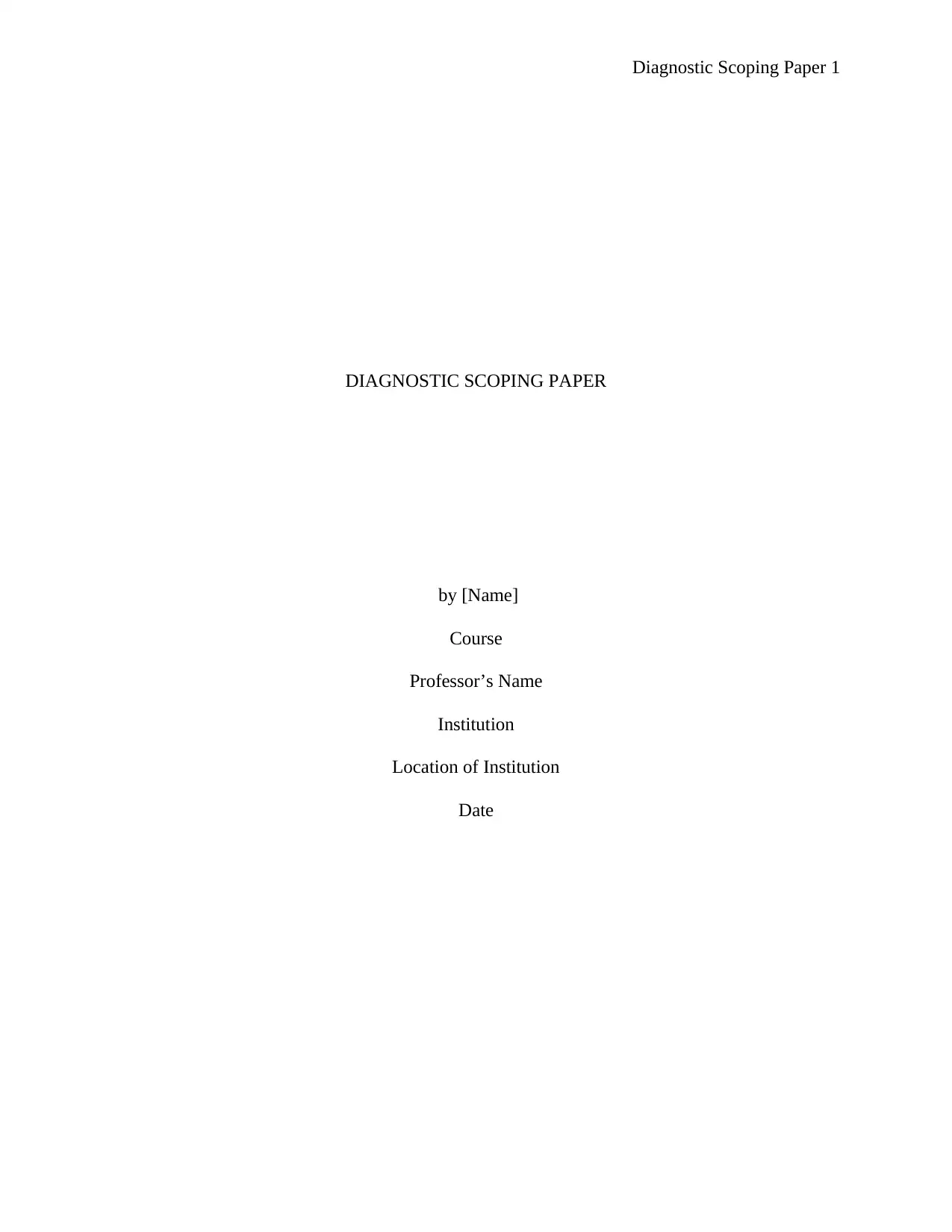
Diagnostic Scoping Paper 1
DIAGNOSTIC SCOPING PAPER
by [Name]
Course
Professor’s Name
Institution
Location of Institution
Date
DIAGNOSTIC SCOPING PAPER
by [Name]
Course
Professor’s Name
Institution
Location of Institution
Date
Paraphrase This Document
Need a fresh take? Get an instant paraphrase of this document with our AI Paraphraser
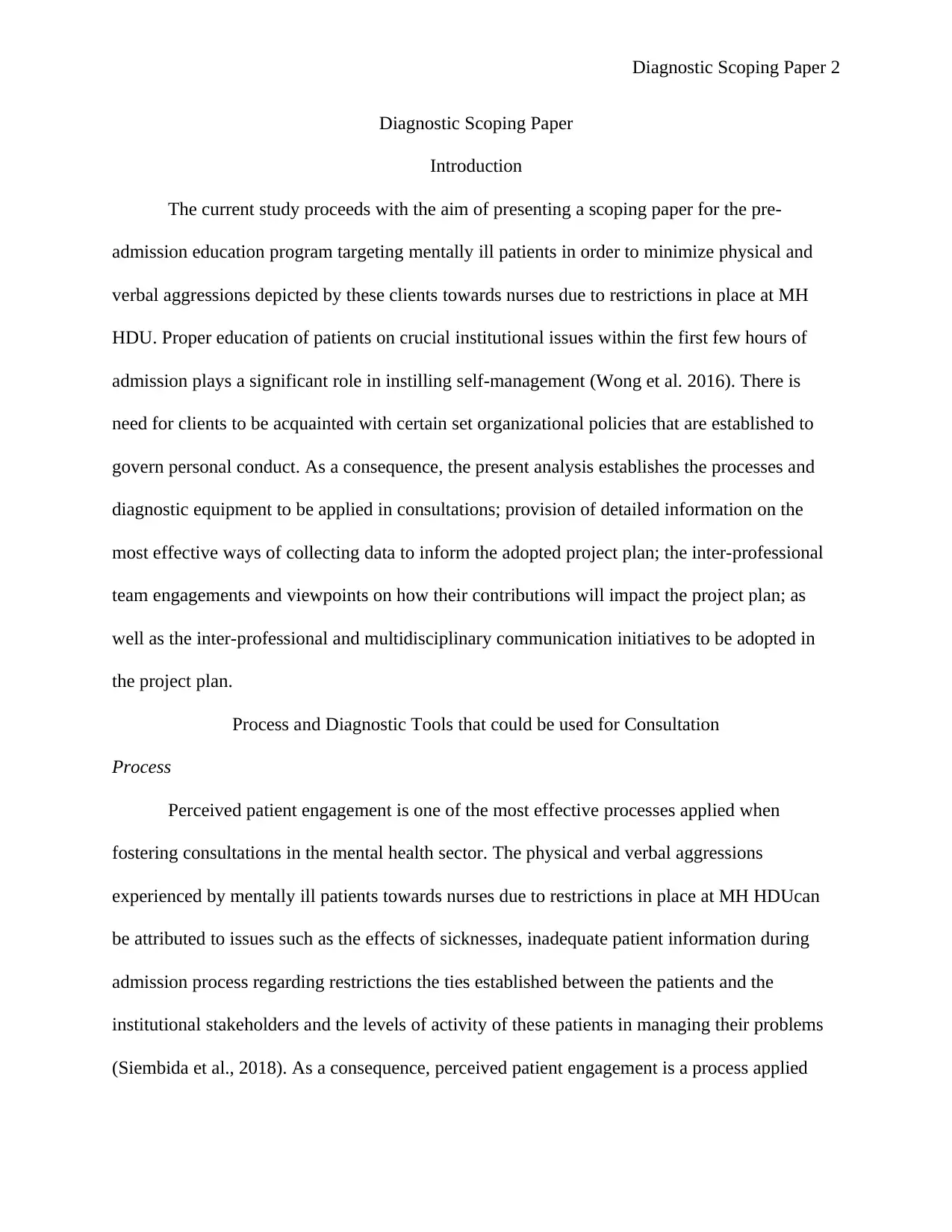
Diagnostic Scoping Paper 2
Diagnostic Scoping Paper
Introduction
The current study proceeds with the aim of presenting a scoping paper for the pre-
admission education program targeting mentally ill patients in order to minimize physical and
verbal aggressions depicted by these clients towards nurses due to restrictions in place at MH
HDU. Proper education of patients on crucial institutional issues within the first few hours of
admission plays a significant role in instilling self-management (Wong et al. 2016). There is
need for clients to be acquainted with certain set organizational policies that are established to
govern personal conduct. As a consequence, the present analysis establishes the processes and
diagnostic equipment to be applied in consultations; provision of detailed information on the
most effective ways of collecting data to inform the adopted project plan; the inter-professional
team engagements and viewpoints on how their contributions will impact the project plan; as
well as the inter-professional and multidisciplinary communication initiatives to be adopted in
the project plan.
Process and Diagnostic Tools that could be used for Consultation
Process
Perceived patient engagement is one of the most effective processes applied when
fostering consultations in the mental health sector. The physical and verbal aggressions
experienced by mentally ill patients towards nurses due to restrictions in place at MH HDUcan
be attributed to issues such as the effects of sicknesses, inadequate patient information during
admission process regarding restrictions the ties established between the patients and the
institutional stakeholders and the levels of activity of these patients in managing their problems
(Siembida et al., 2018). As a consequence, perceived patient engagement is a process applied
Diagnostic Scoping Paper
Introduction
The current study proceeds with the aim of presenting a scoping paper for the pre-
admission education program targeting mentally ill patients in order to minimize physical and
verbal aggressions depicted by these clients towards nurses due to restrictions in place at MH
HDU. Proper education of patients on crucial institutional issues within the first few hours of
admission plays a significant role in instilling self-management (Wong et al. 2016). There is
need for clients to be acquainted with certain set organizational policies that are established to
govern personal conduct. As a consequence, the present analysis establishes the processes and
diagnostic equipment to be applied in consultations; provision of detailed information on the
most effective ways of collecting data to inform the adopted project plan; the inter-professional
team engagements and viewpoints on how their contributions will impact the project plan; as
well as the inter-professional and multidisciplinary communication initiatives to be adopted in
the project plan.
Process and Diagnostic Tools that could be used for Consultation
Process
Perceived patient engagement is one of the most effective processes applied when
fostering consultations in the mental health sector. The physical and verbal aggressions
experienced by mentally ill patients towards nurses due to restrictions in place at MH HDUcan
be attributed to issues such as the effects of sicknesses, inadequate patient information during
admission process regarding restrictions the ties established between the patients and the
institutional stakeholders and the levels of activity of these patients in managing their problems
(Siembida et al., 2018). As a consequence, perceived patient engagement is a process applied
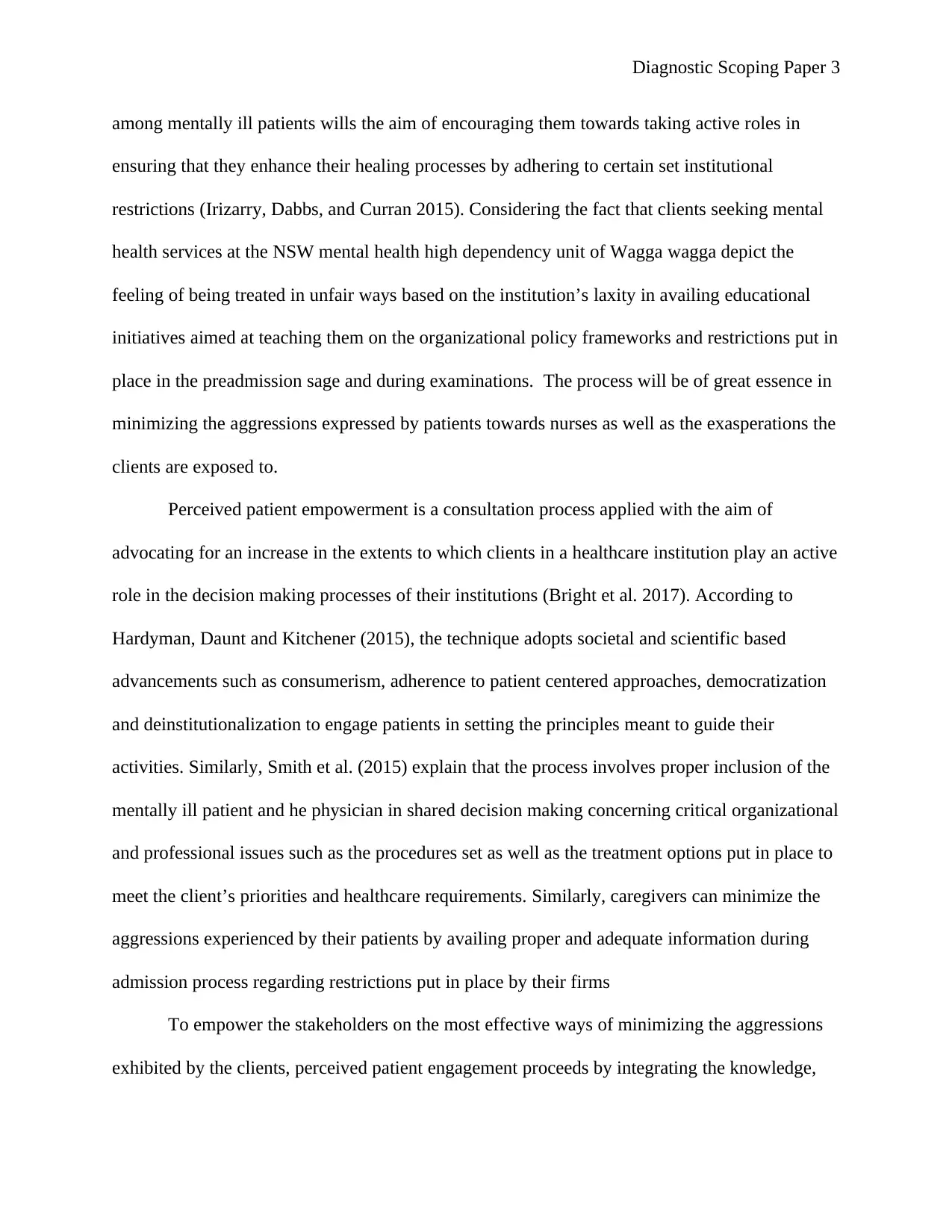
Diagnostic Scoping Paper 3
among mentally ill patients wills the aim of encouraging them towards taking active roles in
ensuring that they enhance their healing processes by adhering to certain set institutional
restrictions (Irizarry, Dabbs, and Curran 2015). Considering the fact that clients seeking mental
health services at the NSW mental health high dependency unit of Wagga wagga depict the
feeling of being treated in unfair ways based on the institution’s laxity in availing educational
initiatives aimed at teaching them on the organizational policy frameworks and restrictions put in
place in the preadmission sage and during examinations. The process will be of great essence in
minimizing the aggressions expressed by patients towards nurses as well as the exasperations the
clients are exposed to.
Perceived patient empowerment is a consultation process applied with the aim of
advocating for an increase in the extents to which clients in a healthcare institution play an active
role in the decision making processes of their institutions (Bright et al. 2017). According to
Hardyman, Daunt and Kitchener (2015), the technique adopts societal and scientific based
advancements such as consumerism, adherence to patient centered approaches, democratization
and deinstitutionalization to engage patients in setting the principles meant to guide their
activities. Similarly, Smith et al. (2015) explain that the process involves proper inclusion of the
mentally ill patient and he physician in shared decision making concerning critical organizational
and professional issues such as the procedures set as well as the treatment options put in place to
meet the client’s priorities and healthcare requirements. Similarly, caregivers can minimize the
aggressions experienced by their patients by availing proper and adequate information during
admission process regarding restrictions put in place by their firms
To empower the stakeholders on the most effective ways of minimizing the aggressions
exhibited by the clients, perceived patient engagement proceeds by integrating the knowledge,
among mentally ill patients wills the aim of encouraging them towards taking active roles in
ensuring that they enhance their healing processes by adhering to certain set institutional
restrictions (Irizarry, Dabbs, and Curran 2015). Considering the fact that clients seeking mental
health services at the NSW mental health high dependency unit of Wagga wagga depict the
feeling of being treated in unfair ways based on the institution’s laxity in availing educational
initiatives aimed at teaching them on the organizational policy frameworks and restrictions put in
place in the preadmission sage and during examinations. The process will be of great essence in
minimizing the aggressions expressed by patients towards nurses as well as the exasperations the
clients are exposed to.
Perceived patient empowerment is a consultation process applied with the aim of
advocating for an increase in the extents to which clients in a healthcare institution play an active
role in the decision making processes of their institutions (Bright et al. 2017). According to
Hardyman, Daunt and Kitchener (2015), the technique adopts societal and scientific based
advancements such as consumerism, adherence to patient centered approaches, democratization
and deinstitutionalization to engage patients in setting the principles meant to guide their
activities. Similarly, Smith et al. (2015) explain that the process involves proper inclusion of the
mentally ill patient and he physician in shared decision making concerning critical organizational
and professional issues such as the procedures set as well as the treatment options put in place to
meet the client’s priorities and healthcare requirements. Similarly, caregivers can minimize the
aggressions experienced by their patients by availing proper and adequate information during
admission process regarding restrictions put in place by their firms
To empower the stakeholders on the most effective ways of minimizing the aggressions
exhibited by the clients, perceived patient engagement proceeds by integrating the knowledge,
⊘ This is a preview!⊘
Do you want full access?
Subscribe today to unlock all pages.

Trusted by 1+ million students worldwide
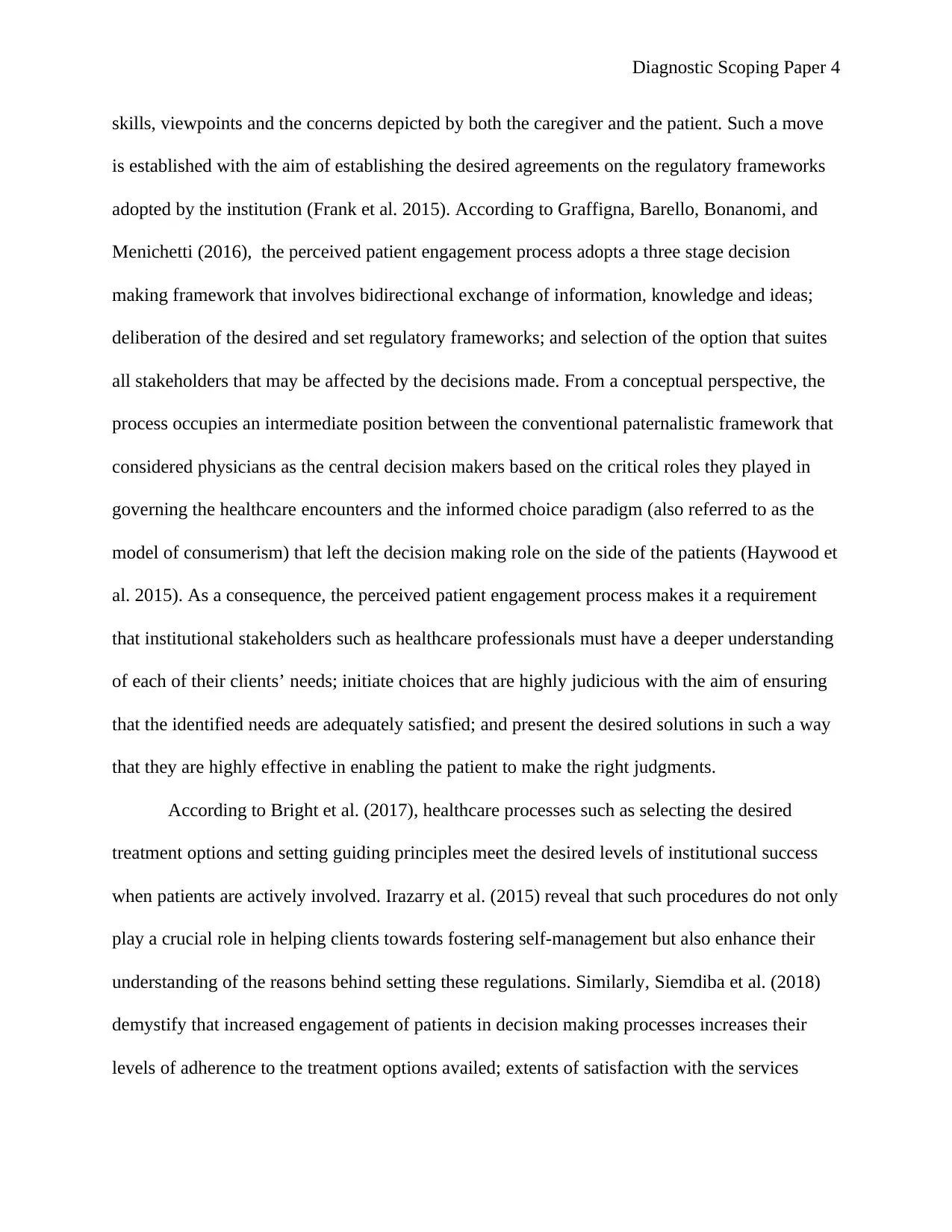
Diagnostic Scoping Paper 4
skills, viewpoints and the concerns depicted by both the caregiver and the patient. Such a move
is established with the aim of establishing the desired agreements on the regulatory frameworks
adopted by the institution (Frank et al. 2015). According to Graffigna, Barello, Bonanomi, and
Menichetti (2016), the perceived patient engagement process adopts a three stage decision
making framework that involves bidirectional exchange of information, knowledge and ideas;
deliberation of the desired and set regulatory frameworks; and selection of the option that suites
all stakeholders that may be affected by the decisions made. From a conceptual perspective, the
process occupies an intermediate position between the conventional paternalistic framework that
considered physicians as the central decision makers based on the critical roles they played in
governing the healthcare encounters and the informed choice paradigm (also referred to as the
model of consumerism) that left the decision making role on the side of the patients (Haywood et
al. 2015). As a consequence, the perceived patient engagement process makes it a requirement
that institutional stakeholders such as healthcare professionals must have a deeper understanding
of each of their clients’ needs; initiate choices that are highly judicious with the aim of ensuring
that the identified needs are adequately satisfied; and present the desired solutions in such a way
that they are highly effective in enabling the patient to make the right judgments.
According to Bright et al. (2017), healthcare processes such as selecting the desired
treatment options and setting guiding principles meet the desired levels of institutional success
when patients are actively involved. Irazarry et al. (2015) reveal that such procedures do not only
play a crucial role in helping clients towards fostering self-management but also enhance their
understanding of the reasons behind setting these regulations. Similarly, Siemdiba et al. (2018)
demystify that increased engagement of patients in decision making processes increases their
levels of adherence to the treatment options availed; extents of satisfaction with the services
skills, viewpoints and the concerns depicted by both the caregiver and the patient. Such a move
is established with the aim of establishing the desired agreements on the regulatory frameworks
adopted by the institution (Frank et al. 2015). According to Graffigna, Barello, Bonanomi, and
Menichetti (2016), the perceived patient engagement process adopts a three stage decision
making framework that involves bidirectional exchange of information, knowledge and ideas;
deliberation of the desired and set regulatory frameworks; and selection of the option that suites
all stakeholders that may be affected by the decisions made. From a conceptual perspective, the
process occupies an intermediate position between the conventional paternalistic framework that
considered physicians as the central decision makers based on the critical roles they played in
governing the healthcare encounters and the informed choice paradigm (also referred to as the
model of consumerism) that left the decision making role on the side of the patients (Haywood et
al. 2015). As a consequence, the perceived patient engagement process makes it a requirement
that institutional stakeholders such as healthcare professionals must have a deeper understanding
of each of their clients’ needs; initiate choices that are highly judicious with the aim of ensuring
that the identified needs are adequately satisfied; and present the desired solutions in such a way
that they are highly effective in enabling the patient to make the right judgments.
According to Bright et al. (2017), healthcare processes such as selecting the desired
treatment options and setting guiding principles meet the desired levels of institutional success
when patients are actively involved. Irazarry et al. (2015) reveal that such procedures do not only
play a crucial role in helping clients towards fostering self-management but also enhance their
understanding of the reasons behind setting these regulations. Similarly, Siemdiba et al. (2018)
demystify that increased engagement of patients in decision making processes increases their
levels of adherence to the treatment options availed; extents of satisfaction with the services
Paraphrase This Document
Need a fresh take? Get an instant paraphrase of this document with our AI Paraphraser
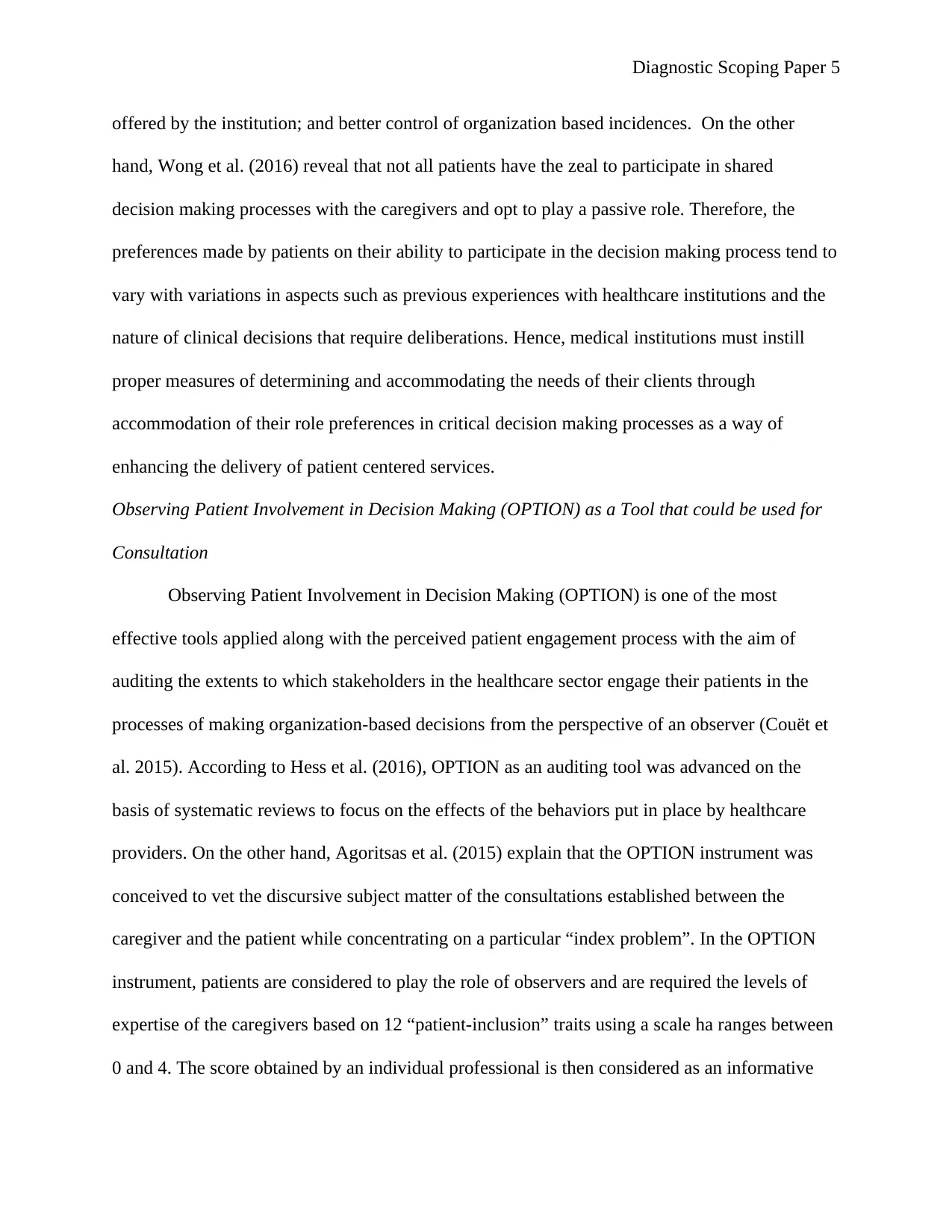
Diagnostic Scoping Paper 5
offered by the institution; and better control of organization based incidences. On the other
hand, Wong et al. (2016) reveal that not all patients have the zeal to participate in shared
decision making processes with the caregivers and opt to play a passive role. Therefore, the
preferences made by patients on their ability to participate in the decision making process tend to
vary with variations in aspects such as previous experiences with healthcare institutions and the
nature of clinical decisions that require deliberations. Hence, medical institutions must instill
proper measures of determining and accommodating the needs of their clients through
accommodation of their role preferences in critical decision making processes as a way of
enhancing the delivery of patient centered services.
Observing Patient Involvement in Decision Making (OPTION) as a Tool that could be used for
Consultation
Observing Patient Involvement in Decision Making (OPTION) is one of the most
effective tools applied along with the perceived patient engagement process with the aim of
auditing the extents to which stakeholders in the healthcare sector engage their patients in the
processes of making organization-based decisions from the perspective of an observer (Couët et
al. 2015). According to Hess et al. (2016), OPTION as an auditing tool was advanced on the
basis of systematic reviews to focus on the effects of the behaviors put in place by healthcare
providers. On the other hand, Agoritsas et al. (2015) explain that the OPTION instrument was
conceived to vet the discursive subject matter of the consultations established between the
caregiver and the patient while concentrating on a particular “index problem”. In the OPTION
instrument, patients are considered to play the role of observers and are required the levels of
expertise of the caregivers based on 12 “patient-inclusion” traits using a scale ha ranges between
0 and 4. The score obtained by an individual professional is then considered as an informative
offered by the institution; and better control of organization based incidences. On the other
hand, Wong et al. (2016) reveal that not all patients have the zeal to participate in shared
decision making processes with the caregivers and opt to play a passive role. Therefore, the
preferences made by patients on their ability to participate in the decision making process tend to
vary with variations in aspects such as previous experiences with healthcare institutions and the
nature of clinical decisions that require deliberations. Hence, medical institutions must instill
proper measures of determining and accommodating the needs of their clients through
accommodation of their role preferences in critical decision making processes as a way of
enhancing the delivery of patient centered services.
Observing Patient Involvement in Decision Making (OPTION) as a Tool that could be used for
Consultation
Observing Patient Involvement in Decision Making (OPTION) is one of the most
effective tools applied along with the perceived patient engagement process with the aim of
auditing the extents to which stakeholders in the healthcare sector engage their patients in the
processes of making organization-based decisions from the perspective of an observer (Couët et
al. 2015). According to Hess et al. (2016), OPTION as an auditing tool was advanced on the
basis of systematic reviews to focus on the effects of the behaviors put in place by healthcare
providers. On the other hand, Agoritsas et al. (2015) explain that the OPTION instrument was
conceived to vet the discursive subject matter of the consultations established between the
caregiver and the patient while concentrating on a particular “index problem”. In the OPTION
instrument, patients are considered to play the role of observers and are required the levels of
expertise of the caregivers based on 12 “patient-inclusion” traits using a scale ha ranges between
0 and 4. The score obtained by an individual professional is then considered as an informative
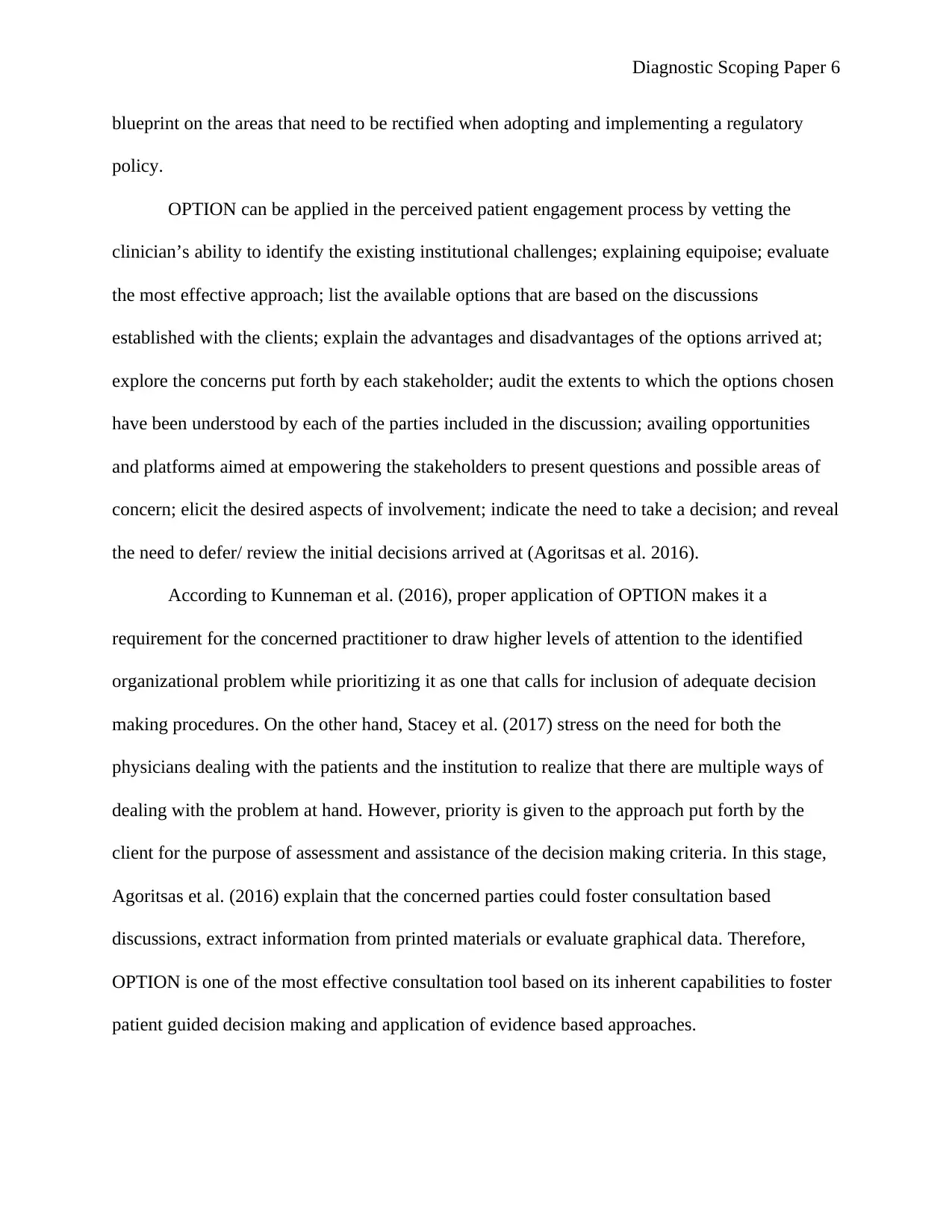
Diagnostic Scoping Paper 6
blueprint on the areas that need to be rectified when adopting and implementing a regulatory
policy.
OPTION can be applied in the perceived patient engagement process by vetting the
clinician’s ability to identify the existing institutional challenges; explaining equipoise; evaluate
the most effective approach; list the available options that are based on the discussions
established with the clients; explain the advantages and disadvantages of the options arrived at;
explore the concerns put forth by each stakeholder; audit the extents to which the options chosen
have been understood by each of the parties included in the discussion; availing opportunities
and platforms aimed at empowering the stakeholders to present questions and possible areas of
concern; elicit the desired aspects of involvement; indicate the need to take a decision; and reveal
the need to defer/ review the initial decisions arrived at (Agoritsas et al. 2016).
According to Kunneman et al. (2016), proper application of OPTION makes it a
requirement for the concerned practitioner to draw higher levels of attention to the identified
organizational problem while prioritizing it as one that calls for inclusion of adequate decision
making procedures. On the other hand, Stacey et al. (2017) stress on the need for both the
physicians dealing with the patients and the institution to realize that there are multiple ways of
dealing with the problem at hand. However, priority is given to the approach put forth by the
client for the purpose of assessment and assistance of the decision making criteria. In this stage,
Agoritsas et al. (2016) explain that the concerned parties could foster consultation based
discussions, extract information from printed materials or evaluate graphical data. Therefore,
OPTION is one of the most effective consultation tool based on its inherent capabilities to foster
patient guided decision making and application of evidence based approaches.
blueprint on the areas that need to be rectified when adopting and implementing a regulatory
policy.
OPTION can be applied in the perceived patient engagement process by vetting the
clinician’s ability to identify the existing institutional challenges; explaining equipoise; evaluate
the most effective approach; list the available options that are based on the discussions
established with the clients; explain the advantages and disadvantages of the options arrived at;
explore the concerns put forth by each stakeholder; audit the extents to which the options chosen
have been understood by each of the parties included in the discussion; availing opportunities
and platforms aimed at empowering the stakeholders to present questions and possible areas of
concern; elicit the desired aspects of involvement; indicate the need to take a decision; and reveal
the need to defer/ review the initial decisions arrived at (Agoritsas et al. 2016).
According to Kunneman et al. (2016), proper application of OPTION makes it a
requirement for the concerned practitioner to draw higher levels of attention to the identified
organizational problem while prioritizing it as one that calls for inclusion of adequate decision
making procedures. On the other hand, Stacey et al. (2017) stress on the need for both the
physicians dealing with the patients and the institution to realize that there are multiple ways of
dealing with the problem at hand. However, priority is given to the approach put forth by the
client for the purpose of assessment and assistance of the decision making criteria. In this stage,
Agoritsas et al. (2016) explain that the concerned parties could foster consultation based
discussions, extract information from printed materials or evaluate graphical data. Therefore,
OPTION is one of the most effective consultation tool based on its inherent capabilities to foster
patient guided decision making and application of evidence based approaches.
⊘ This is a preview!⊘
Do you want full access?
Subscribe today to unlock all pages.

Trusted by 1+ million students worldwide
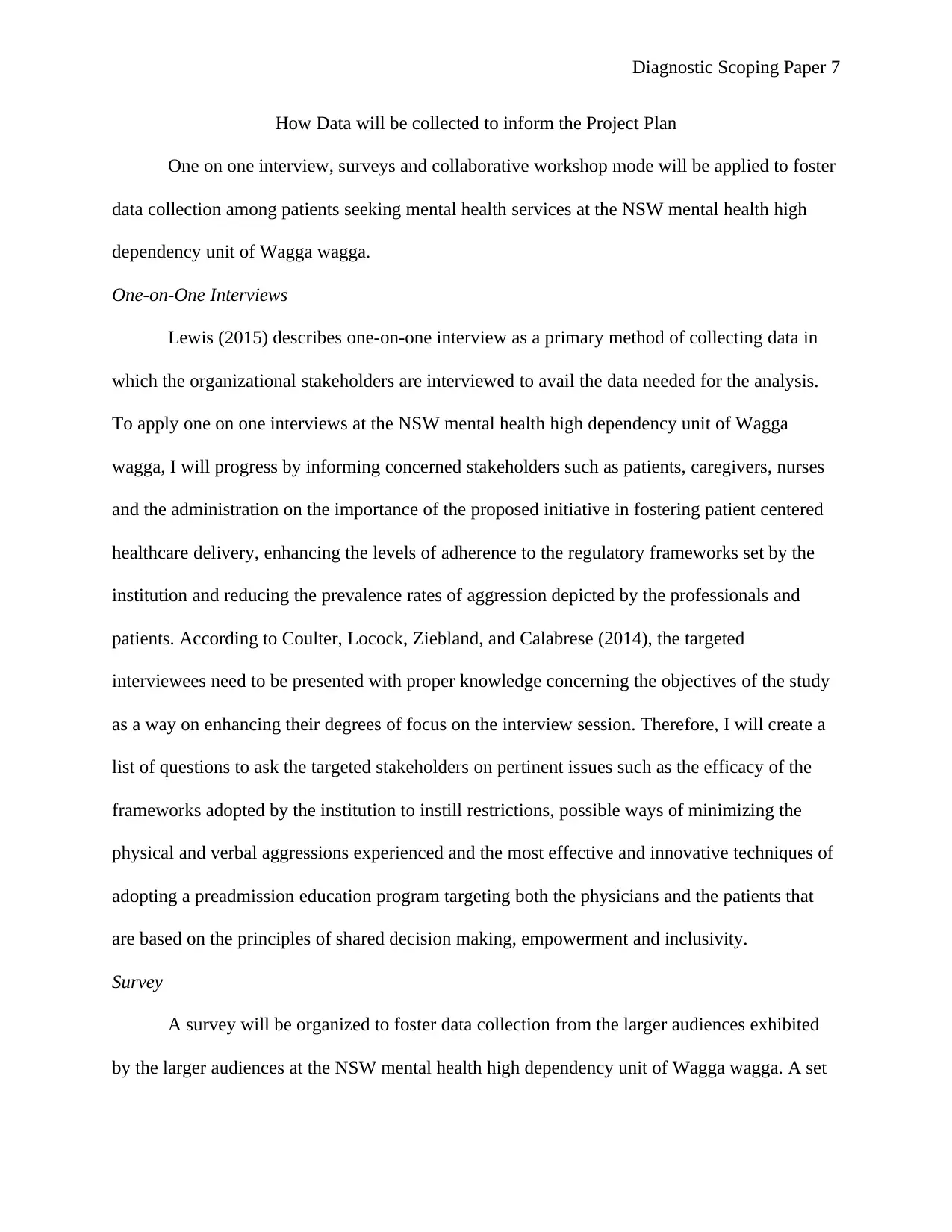
Diagnostic Scoping Paper 7
How Data will be collected to inform the Project Plan
One on one interview, surveys and collaborative workshop mode will be applied to foster
data collection among patients seeking mental health services at the NSW mental health high
dependency unit of Wagga wagga.
One-on-One Interviews
Lewis (2015) describes one-on-one interview as a primary method of collecting data in
which the organizational stakeholders are interviewed to avail the data needed for the analysis.
To apply one on one interviews at the NSW mental health high dependency unit of Wagga
wagga, I will progress by informing concerned stakeholders such as patients, caregivers, nurses
and the administration on the importance of the proposed initiative in fostering patient centered
healthcare delivery, enhancing the levels of adherence to the regulatory frameworks set by the
institution and reducing the prevalence rates of aggression depicted by the professionals and
patients. According to Coulter, Locock, Ziebland, and Calabrese (2014), the targeted
interviewees need to be presented with proper knowledge concerning the objectives of the study
as a way on enhancing their degrees of focus on the interview session. Therefore, I will create a
list of questions to ask the targeted stakeholders on pertinent issues such as the efficacy of the
frameworks adopted by the institution to instill restrictions, possible ways of minimizing the
physical and verbal aggressions experienced and the most effective and innovative techniques of
adopting a preadmission education program targeting both the physicians and the patients that
are based on the principles of shared decision making, empowerment and inclusivity.
Survey
A survey will be organized to foster data collection from the larger audiences exhibited
by the larger audiences at the NSW mental health high dependency unit of Wagga wagga. A set
How Data will be collected to inform the Project Plan
One on one interview, surveys and collaborative workshop mode will be applied to foster
data collection among patients seeking mental health services at the NSW mental health high
dependency unit of Wagga wagga.
One-on-One Interviews
Lewis (2015) describes one-on-one interview as a primary method of collecting data in
which the organizational stakeholders are interviewed to avail the data needed for the analysis.
To apply one on one interviews at the NSW mental health high dependency unit of Wagga
wagga, I will progress by informing concerned stakeholders such as patients, caregivers, nurses
and the administration on the importance of the proposed initiative in fostering patient centered
healthcare delivery, enhancing the levels of adherence to the regulatory frameworks set by the
institution and reducing the prevalence rates of aggression depicted by the professionals and
patients. According to Coulter, Locock, Ziebland, and Calabrese (2014), the targeted
interviewees need to be presented with proper knowledge concerning the objectives of the study
as a way on enhancing their degrees of focus on the interview session. Therefore, I will create a
list of questions to ask the targeted stakeholders on pertinent issues such as the efficacy of the
frameworks adopted by the institution to instill restrictions, possible ways of minimizing the
physical and verbal aggressions experienced and the most effective and innovative techniques of
adopting a preadmission education program targeting both the physicians and the patients that
are based on the principles of shared decision making, empowerment and inclusivity.
Survey
A survey will be organized to foster data collection from the larger audiences exhibited
by the larger audiences at the NSW mental health high dependency unit of Wagga wagga. A set
Paraphrase This Document
Need a fresh take? Get an instant paraphrase of this document with our AI Paraphraser
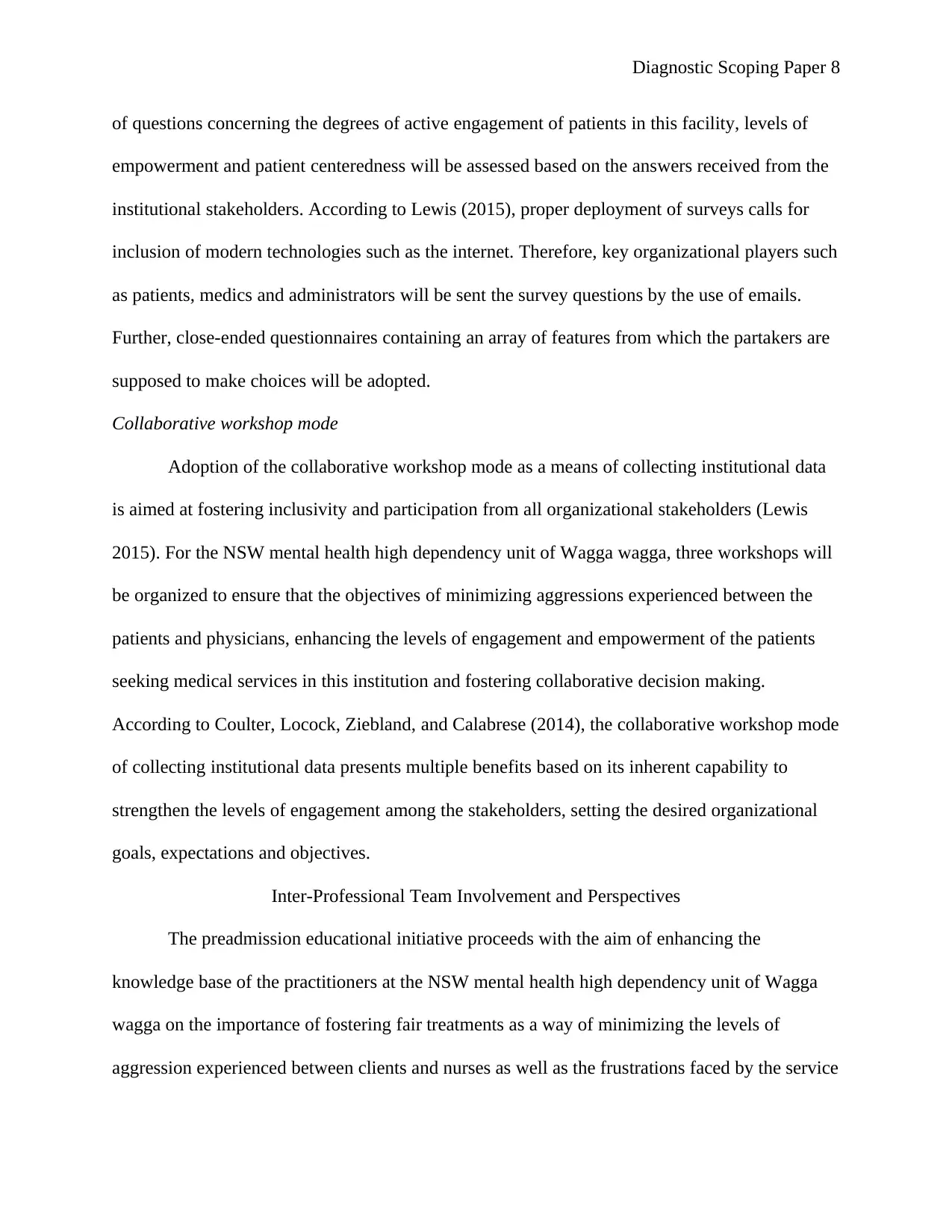
Diagnostic Scoping Paper 8
of questions concerning the degrees of active engagement of patients in this facility, levels of
empowerment and patient centeredness will be assessed based on the answers received from the
institutional stakeholders. According to Lewis (2015), proper deployment of surveys calls for
inclusion of modern technologies such as the internet. Therefore, key organizational players such
as patients, medics and administrators will be sent the survey questions by the use of emails.
Further, close-ended questionnaires containing an array of features from which the partakers are
supposed to make choices will be adopted.
Collaborative workshop mode
Adoption of the collaborative workshop mode as a means of collecting institutional data
is aimed at fostering inclusivity and participation from all organizational stakeholders (Lewis
2015). For the NSW mental health high dependency unit of Wagga wagga, three workshops will
be organized to ensure that the objectives of minimizing aggressions experienced between the
patients and physicians, enhancing the levels of engagement and empowerment of the patients
seeking medical services in this institution and fostering collaborative decision making.
According to Coulter, Locock, Ziebland, and Calabrese (2014), the collaborative workshop mode
of collecting institutional data presents multiple benefits based on its inherent capability to
strengthen the levels of engagement among the stakeholders, setting the desired organizational
goals, expectations and objectives.
Inter-Professional Team Involvement and Perspectives
The preadmission educational initiative proceeds with the aim of enhancing the
knowledge base of the practitioners at the NSW mental health high dependency unit of Wagga
wagga on the importance of fostering fair treatments as a way of minimizing the levels of
aggression experienced between clients and nurses as well as the frustrations faced by the service
of questions concerning the degrees of active engagement of patients in this facility, levels of
empowerment and patient centeredness will be assessed based on the answers received from the
institutional stakeholders. According to Lewis (2015), proper deployment of surveys calls for
inclusion of modern technologies such as the internet. Therefore, key organizational players such
as patients, medics and administrators will be sent the survey questions by the use of emails.
Further, close-ended questionnaires containing an array of features from which the partakers are
supposed to make choices will be adopted.
Collaborative workshop mode
Adoption of the collaborative workshop mode as a means of collecting institutional data
is aimed at fostering inclusivity and participation from all organizational stakeholders (Lewis
2015). For the NSW mental health high dependency unit of Wagga wagga, three workshops will
be organized to ensure that the objectives of minimizing aggressions experienced between the
patients and physicians, enhancing the levels of engagement and empowerment of the patients
seeking medical services in this institution and fostering collaborative decision making.
According to Coulter, Locock, Ziebland, and Calabrese (2014), the collaborative workshop mode
of collecting institutional data presents multiple benefits based on its inherent capability to
strengthen the levels of engagement among the stakeholders, setting the desired organizational
goals, expectations and objectives.
Inter-Professional Team Involvement and Perspectives
The preadmission educational initiative proceeds with the aim of enhancing the
knowledge base of the practitioners at the NSW mental health high dependency unit of Wagga
wagga on the importance of fostering fair treatments as a way of minimizing the levels of
aggression experienced between clients and nurses as well as the frustrations faced by the service
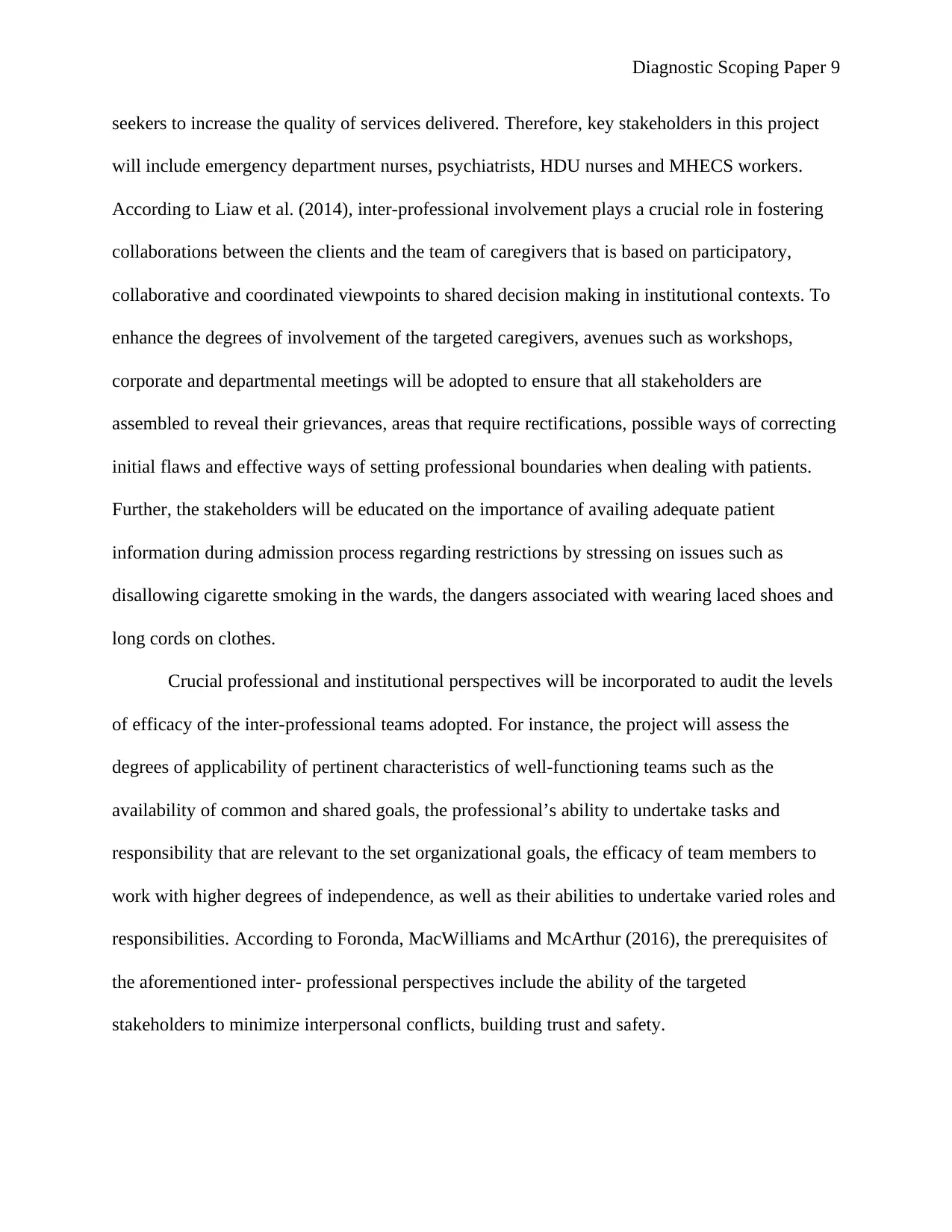
Diagnostic Scoping Paper 9
seekers to increase the quality of services delivered. Therefore, key stakeholders in this project
will include emergency department nurses, psychiatrists, HDU nurses and MHECS workers.
According to Liaw et al. (2014), inter-professional involvement plays a crucial role in fostering
collaborations between the clients and the team of caregivers that is based on participatory,
collaborative and coordinated viewpoints to shared decision making in institutional contexts. To
enhance the degrees of involvement of the targeted caregivers, avenues such as workshops,
corporate and departmental meetings will be adopted to ensure that all stakeholders are
assembled to reveal their grievances, areas that require rectifications, possible ways of correcting
initial flaws and effective ways of setting professional boundaries when dealing with patients.
Further, the stakeholders will be educated on the importance of availing adequate patient
information during admission process regarding restrictions by stressing on issues such as
disallowing cigarette smoking in the wards, the dangers associated with wearing laced shoes and
long cords on clothes.
Crucial professional and institutional perspectives will be incorporated to audit the levels
of efficacy of the inter-professional teams adopted. For instance, the project will assess the
degrees of applicability of pertinent characteristics of well-functioning teams such as the
availability of common and shared goals, the professional’s ability to undertake tasks and
responsibility that are relevant to the set organizational goals, the efficacy of team members to
work with higher degrees of independence, as well as their abilities to undertake varied roles and
responsibilities. According to Foronda, MacWilliams and McArthur (2016), the prerequisites of
the aforementioned inter- professional perspectives include the ability of the targeted
stakeholders to minimize interpersonal conflicts, building trust and safety.
seekers to increase the quality of services delivered. Therefore, key stakeholders in this project
will include emergency department nurses, psychiatrists, HDU nurses and MHECS workers.
According to Liaw et al. (2014), inter-professional involvement plays a crucial role in fostering
collaborations between the clients and the team of caregivers that is based on participatory,
collaborative and coordinated viewpoints to shared decision making in institutional contexts. To
enhance the degrees of involvement of the targeted caregivers, avenues such as workshops,
corporate and departmental meetings will be adopted to ensure that all stakeholders are
assembled to reveal their grievances, areas that require rectifications, possible ways of correcting
initial flaws and effective ways of setting professional boundaries when dealing with patients.
Further, the stakeholders will be educated on the importance of availing adequate patient
information during admission process regarding restrictions by stressing on issues such as
disallowing cigarette smoking in the wards, the dangers associated with wearing laced shoes and
long cords on clothes.
Crucial professional and institutional perspectives will be incorporated to audit the levels
of efficacy of the inter-professional teams adopted. For instance, the project will assess the
degrees of applicability of pertinent characteristics of well-functioning teams such as the
availability of common and shared goals, the professional’s ability to undertake tasks and
responsibility that are relevant to the set organizational goals, the efficacy of team members to
work with higher degrees of independence, as well as their abilities to undertake varied roles and
responsibilities. According to Foronda, MacWilliams and McArthur (2016), the prerequisites of
the aforementioned inter- professional perspectives include the ability of the targeted
stakeholders to minimize interpersonal conflicts, building trust and safety.
⊘ This is a preview!⊘
Do you want full access?
Subscribe today to unlock all pages.

Trusted by 1+ million students worldwide
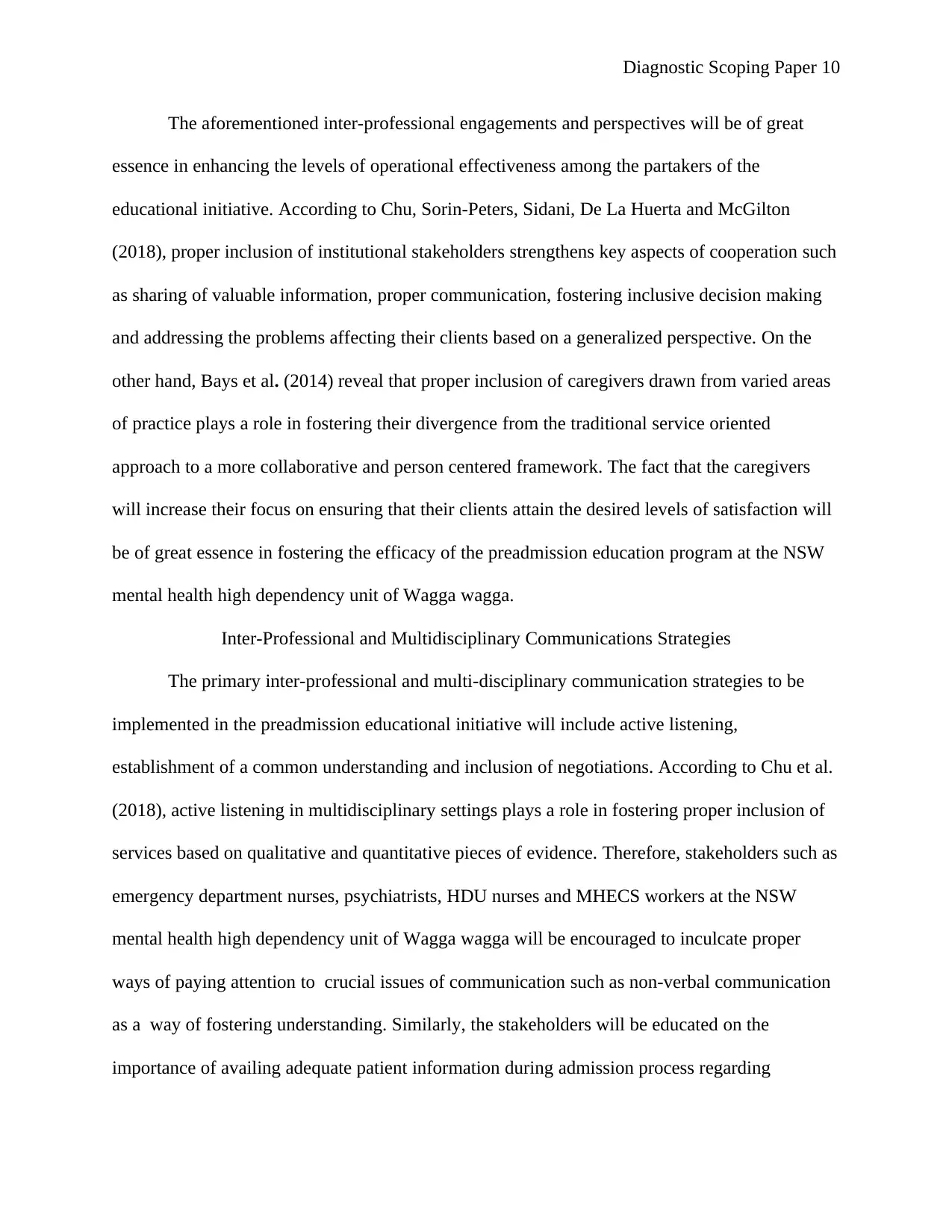
Diagnostic Scoping Paper 10
The aforementioned inter-professional engagements and perspectives will be of great
essence in enhancing the levels of operational effectiveness among the partakers of the
educational initiative. According to Chu, Sorin-Peters, Sidani, De La Huerta and McGilton
(2018), proper inclusion of institutional stakeholders strengthens key aspects of cooperation such
as sharing of valuable information, proper communication, fostering inclusive decision making
and addressing the problems affecting their clients based on a generalized perspective. On the
other hand, Bays et al. (2014) reveal that proper inclusion of caregivers drawn from varied areas
of practice plays a role in fostering their divergence from the traditional service oriented
approach to a more collaborative and person centered framework. The fact that the caregivers
will increase their focus on ensuring that their clients attain the desired levels of satisfaction will
be of great essence in fostering the efficacy of the preadmission education program at the NSW
mental health high dependency unit of Wagga wagga.
Inter-Professional and Multidisciplinary Communications Strategies
The primary inter-professional and multi-disciplinary communication strategies to be
implemented in the preadmission educational initiative will include active listening,
establishment of a common understanding and inclusion of negotiations. According to Chu et al.
(2018), active listening in multidisciplinary settings plays a role in fostering proper inclusion of
services based on qualitative and quantitative pieces of evidence. Therefore, stakeholders such as
emergency department nurses, psychiatrists, HDU nurses and MHECS workers at the NSW
mental health high dependency unit of Wagga wagga will be encouraged to inculcate proper
ways of paying attention to crucial issues of communication such as non-verbal communication
as a way of fostering understanding. Similarly, the stakeholders will be educated on the
importance of availing adequate patient information during admission process regarding
The aforementioned inter-professional engagements and perspectives will be of great
essence in enhancing the levels of operational effectiveness among the partakers of the
educational initiative. According to Chu, Sorin-Peters, Sidani, De La Huerta and McGilton
(2018), proper inclusion of institutional stakeholders strengthens key aspects of cooperation such
as sharing of valuable information, proper communication, fostering inclusive decision making
and addressing the problems affecting their clients based on a generalized perspective. On the
other hand, Bays et al. (2014) reveal that proper inclusion of caregivers drawn from varied areas
of practice plays a role in fostering their divergence from the traditional service oriented
approach to a more collaborative and person centered framework. The fact that the caregivers
will increase their focus on ensuring that their clients attain the desired levels of satisfaction will
be of great essence in fostering the efficacy of the preadmission education program at the NSW
mental health high dependency unit of Wagga wagga.
Inter-Professional and Multidisciplinary Communications Strategies
The primary inter-professional and multi-disciplinary communication strategies to be
implemented in the preadmission educational initiative will include active listening,
establishment of a common understanding and inclusion of negotiations. According to Chu et al.
(2018), active listening in multidisciplinary settings plays a role in fostering proper inclusion of
services based on qualitative and quantitative pieces of evidence. Therefore, stakeholders such as
emergency department nurses, psychiatrists, HDU nurses and MHECS workers at the NSW
mental health high dependency unit of Wagga wagga will be encouraged to inculcate proper
ways of paying attention to crucial issues of communication such as non-verbal communication
as a way of fostering understanding. Similarly, the stakeholders will be educated on the
importance of availing adequate patient information during admission process regarding
Paraphrase This Document
Need a fresh take? Get an instant paraphrase of this document with our AI Paraphraser
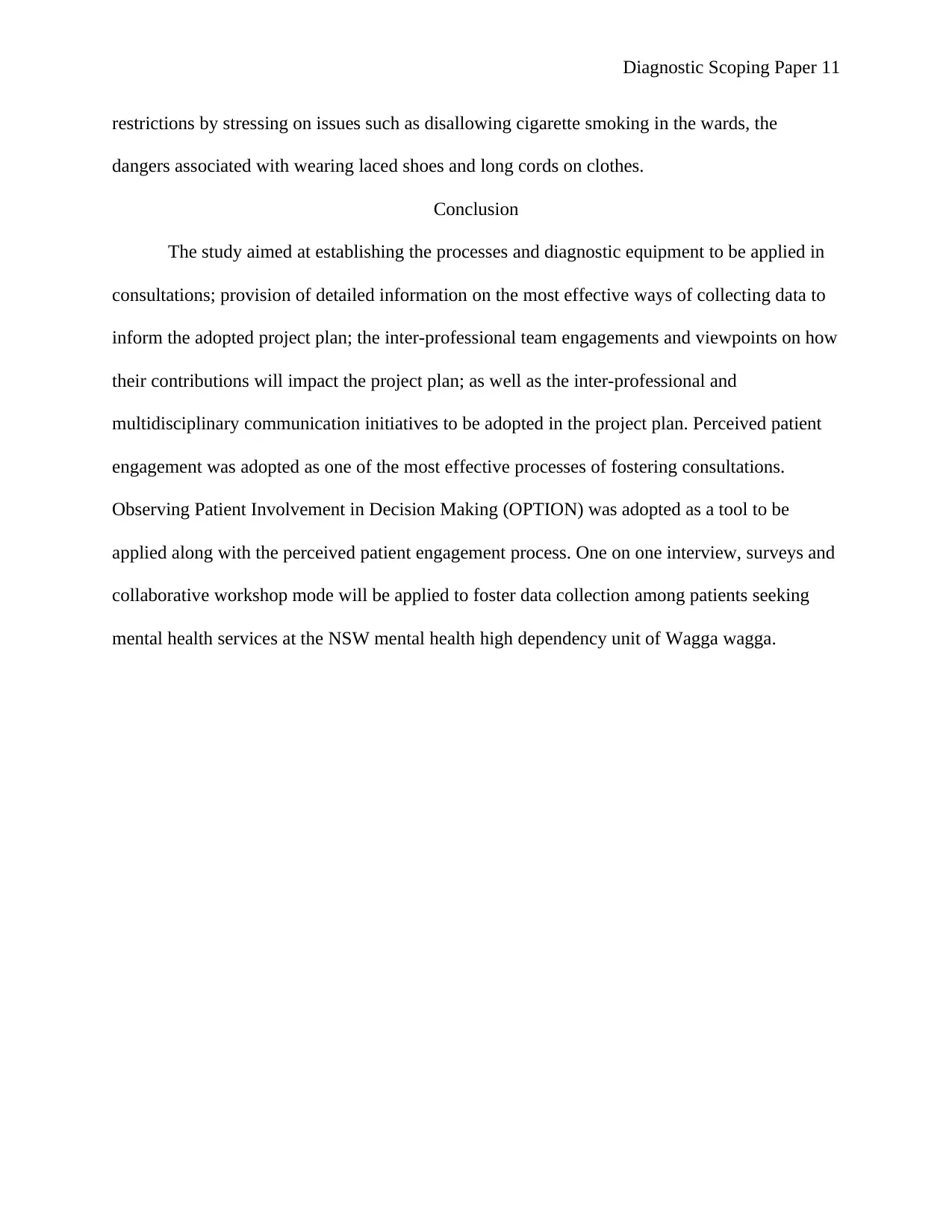
Diagnostic Scoping Paper 11
restrictions by stressing on issues such as disallowing cigarette smoking in the wards, the
dangers associated with wearing laced shoes and long cords on clothes.
Conclusion
The study aimed at establishing the processes and diagnostic equipment to be applied in
consultations; provision of detailed information on the most effective ways of collecting data to
inform the adopted project plan; the inter-professional team engagements and viewpoints on how
their contributions will impact the project plan; as well as the inter-professional and
multidisciplinary communication initiatives to be adopted in the project plan. Perceived patient
engagement was adopted as one of the most effective processes of fostering consultations.
Observing Patient Involvement in Decision Making (OPTION) was adopted as a tool to be
applied along with the perceived patient engagement process. One on one interview, surveys and
collaborative workshop mode will be applied to foster data collection among patients seeking
mental health services at the NSW mental health high dependency unit of Wagga wagga.
restrictions by stressing on issues such as disallowing cigarette smoking in the wards, the
dangers associated with wearing laced shoes and long cords on clothes.
Conclusion
The study aimed at establishing the processes and diagnostic equipment to be applied in
consultations; provision of detailed information on the most effective ways of collecting data to
inform the adopted project plan; the inter-professional team engagements and viewpoints on how
their contributions will impact the project plan; as well as the inter-professional and
multidisciplinary communication initiatives to be adopted in the project plan. Perceived patient
engagement was adopted as one of the most effective processes of fostering consultations.
Observing Patient Involvement in Decision Making (OPTION) was adopted as a tool to be
applied along with the perceived patient engagement process. One on one interview, surveys and
collaborative workshop mode will be applied to foster data collection among patients seeking
mental health services at the NSW mental health high dependency unit of Wagga wagga.
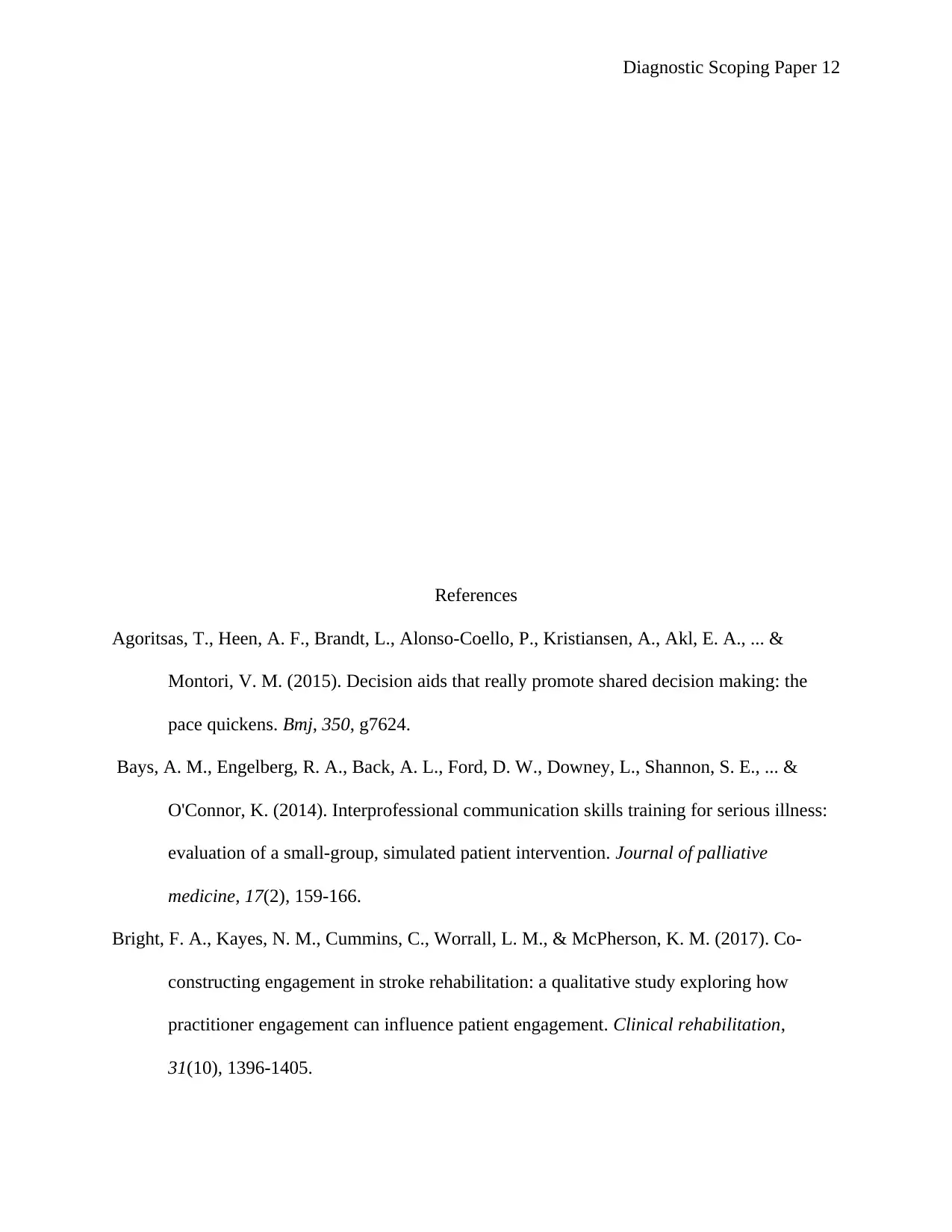
Diagnostic Scoping Paper 12
References
Agoritsas, T., Heen, A. F., Brandt, L., Alonso-Coello, P., Kristiansen, A., Akl, E. A., ... &
Montori, V. M. (2015). Decision aids that really promote shared decision making: the
pace quickens. Bmj, 350, g7624.
Bays, A. M., Engelberg, R. A., Back, A. L., Ford, D. W., Downey, L., Shannon, S. E., ... &
O'Connor, K. (2014). Interprofessional communication skills training for serious illness:
evaluation of a small-group, simulated patient intervention. Journal of palliative
medicine, 17(2), 159-166.
Bright, F. A., Kayes, N. M., Cummins, C., Worrall, L. M., & McPherson, K. M. (2017). Co-
constructing engagement in stroke rehabilitation: a qualitative study exploring how
practitioner engagement can influence patient engagement. Clinical rehabilitation,
31(10), 1396-1405.
References
Agoritsas, T., Heen, A. F., Brandt, L., Alonso-Coello, P., Kristiansen, A., Akl, E. A., ... &
Montori, V. M. (2015). Decision aids that really promote shared decision making: the
pace quickens. Bmj, 350, g7624.
Bays, A. M., Engelberg, R. A., Back, A. L., Ford, D. W., Downey, L., Shannon, S. E., ... &
O'Connor, K. (2014). Interprofessional communication skills training for serious illness:
evaluation of a small-group, simulated patient intervention. Journal of palliative
medicine, 17(2), 159-166.
Bright, F. A., Kayes, N. M., Cummins, C., Worrall, L. M., & McPherson, K. M. (2017). Co-
constructing engagement in stroke rehabilitation: a qualitative study exploring how
practitioner engagement can influence patient engagement. Clinical rehabilitation,
31(10), 1396-1405.
⊘ This is a preview!⊘
Do you want full access?
Subscribe today to unlock all pages.

Trusted by 1+ million students worldwide
1 out of 15
Related Documents
Your All-in-One AI-Powered Toolkit for Academic Success.
+13062052269
info@desklib.com
Available 24*7 on WhatsApp / Email
![[object Object]](/_next/static/media/star-bottom.7253800d.svg)
Unlock your academic potential
Copyright © 2020–2025 A2Z Services. All Rights Reserved. Developed and managed by ZUCOL.




